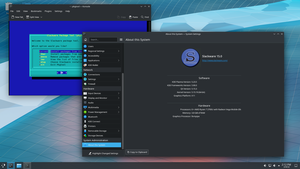More actions
m (Update infoboxes) |
m (Slackware only ships with KDE by default) |
||
| Line 6: | Line 6: | ||
| releasemodel = Stable | | releasemodel = Stable | ||
| packagemanager = [[pkgtool]], slackpkg | | packagemanager = [[pkgtool]], slackpkg | ||
| defaultdesktops = | | defaultdesktops = [[KDE Plasma]] | ||
| usagetype = Desktop, Server | | usagetype = Desktop, Server | ||
| architectures = arm, i586, s390, x86_64 | | architectures = arm, i586, s390, x86_64 | ||
Revision as of 19:37, 6 June 2024
 Slackware Linux logo | |
| Release Status | Maintained |
|---|---|
| Release Model | Stable |
| Package Manager | pkgtool, slackpkg |
| Default Desktops | KDE Plasma |
| Usage Type | Desktop, Server |
| Architectures | arm, i586, s390, x86_64 |
| Website | slackware.com |

Slackware Linux is an independent Linux distribution and the oldest active distribution. The project was founded on July 17th 1993 by Patrick Volkerding.
History
Slackware first released as a fork of SoftLandingSystems (SLS) on July 16th, 1993. By popular demand, to move away from SLS, the installer for Slackware was rewritten, using a tool called "Dialog". Version 1.1.0 released with the Dialog installer.[1]
Other notable releases of Slackware Linux include:
- 1.2.0.1 - With Linux kernel 1.0
- 4.0.0 - First release to ship with KDE
- 7.1 - First release to ship with GNOME
The most recent release was on February 3rd, 2022 with the release of Slackware 15.0.
